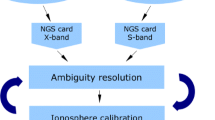Abstract
Turkey established the TUSAGA-AKTIF CORS Network in May 2009. Network software and central server were updated in 2016. With this update, GLONASS message type was determined for Flächen Korrektur Parameter (FKP), Master Auxiliary Concept (MAC) and Virtual Reference Station (VRS) network-based real time kinematic (NRTK) techniques. A 64 bit central server and the Trimble Pivot Platform network software were also acquired with this update. To the best of our knowledge, there has not been a comprehensive accuracy and precision test of the new system yet. In this paper, we aimed to create empirical accuracy and precision model of FKP, MAC and VRS NRTK techniques of the updated system as a function of baseline distance and occupation time. It is intended that surveyors can perform mission planning according to the requirements of accuracy and precision using these models. Seven test points and two check points were chosen to conduct the experiment. The baseline lengths with respect to the closest continuously operating reference stations (CORS) station were determined as 5-20-40-50 km approximately. Three thousand epochs with 2-s sampling interval were obtained for northing, easting and ellipsoidal height coordinate components of NRTK techniques at each point. Assumed true coordinates of each test point were determined by static survey using the GAMIT/GLOBK scientific software. In terms of accuracy and precision, our results show that empirical accuracy model depends only on the occupation time while empirical precision model depends on both the baseline length with respect to the closest CORS station and the occupation time for each NRTK technique. The results indicate that estimated accuracy and precision models can be safely used for mission planning purposes.







Similar content being viewed by others
References
Bae TS, Grejner-Brzezinska D, Mader G, Dennis M (2015) Robust analysis of network-based real-time kinematic for GNSS-derived heights. Sensors 15(10):27215–27229. https://www.tkgm.gov.tr/sites/default/files/icerik_ekleri/tusagay2_0.jpg. Accessed 05 June 2017
Brown N, Keenan R, Richter B, Troyer L (2005) Advances in ambiguity resolution for RTK applications using the new RTCMV3. 0Master- Auxiliary messages. Proc of ION GNSS, Long Beach, California 73–80
Eckl MC, Snay RA, Soler T, Cline MW, Mader GL (2001) Accuracy of GPS-derived relative positions as a function of interstation distance and observing-session duration. J Geod 75(12):633–640
Edwards SJ, Clarke PJ, Penna NT, ve Goebell S (2010) An examination of network RTK GPS services in Great Britain. Surv Rev 42(316):107–121
Garrido MS, Gimenez E, Lacy MA, ve Gil AJ (2011) Testing precise positioning using RTK and NRTK corrections provided by MAC and VRS approaches in SE Spain. J Spat Sci 56(2):169–184
Ge M, Gendt G, Rothacher MA, Shi C, Liu J (2008) Resolution of GPS carrier-phase ambiguities in precise point positioning (PPP) with daily observations. J Geod 82(7):389–399
Herring TA, King RW, McClusky SC (2010) GAMIT reference manual GPS analysis at MIT, Release 10.4, Massachusetts Institute of Technology
Hu GR, Khoo VHS, Goh PC, Law CL (2002) Internet based GPS VRS RTK positioning with multiple reference station network. J Glob Positioning Syst 1(2):113–120
Landau H, Vollath U, Chen X (2002) Virtual reference station systems. J Glob Positioning Syst 1(2):137–143
Raquet J (1998) Development of a method for kinematic GPS carrier phase ambiguity resolution using multiple reference receivers. UCGE rep 20116, University of Calgary, Canada, http://www.geomatics.ucalgary.ca/gradtheses.html
Shariff NS, Musa TA, Ses S, Musliman IA, ve Lee HK (2015) Performance analysis of ISKANDARnet: a research-based network RTK positioning system. J Spat Sci 60(2):365–386
Sun H, Cannon ME, Melgard TE (1999) Real-time GPS reference network carrier phase ambiguity resolution. Proc Nat Tech Meeting Inst Navigation, San Diego, CA, 25–27 January, pp 193–199
Vollath U, Buecherl A, Landau H, Pagels C, Wagner B (2000) Multi-base RTK positioning using virtual reference stations. Proc of 13th International Technical Meeting of the Satellite of the ION, Salt Lake City, UT 123–131
Wübenna G, Bagge A, Schmitz M (2001) Network–based techniques for RTK applications. GPS Society, Japan Institute of Navigation, Tokyo, Japan
Wübenna G, Schmitz M, Bagge A (2005) PPP-RTK: precise point positioning using state-space representation in RTK networks. 18th International Technical Meeting of the Satellite Division of The Institute of Navigation, Long Beach, California 2584–2594
Acknowledgments
This work is supported by the Scientific Research Development Department of Necmettin Erbakan University under Grant number 161419003. The authors are grateful to MIT for providing the licence of the GAMIT/GLOBK software.
Author information
Authors and Affiliations
Corresponding author
Rights and permissions
About this article
Cite this article
Öğütcü, S., Kalaycı, İ. Accuracy and precision of network-based RTK techniques as a function of baseline distance and occupation time. Arab J Geosci 11, 354 (2018). https://doi.org/10.1007/s12517-018-3712-2
Received:
Accepted:
Published:
DOI: https://doi.org/10.1007/s12517-018-3712-2




